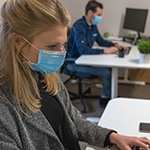More than three quarters of organizations list an active shooter situation as their top safety threat, according to the 2018 Active Shooter Preparedness Report, compiled by Everbridge in partnership with Security Management. The study focuses on the level of enterprise preparedness for these increasingly prevalent, and potentially tragic and devastating events.
The findings, when compared to the inaugural 2016 report, portray a corporate environment with heightened security awareness, which has not, however, translated into tangible preparedness efforts for the majority of organizations.
Heightened Awareness
Seventy-five percent of respondents listed active shooter situations as the “top threat” they are preparing for – up from 64 percent in 2016 – and outranking concerns such as natural disasters, cyberattacks and supply chain disruptions. Additionally, more than twice as many respondents felt that their organization was well prepared for an active shooter incident – from 19 percent in 2016 to 40 percent in 2018. More than two-thirds also reported that their organization was more prepared than two years ago.
Preparedness Deficits
In today’s modern threat environment, organizations are increasingly seeking new tools, processes and technologies to secure their facilities, locate and account for their people and ensure life safety for all employees. However, increased awareness and perceptions of preparedness have not translated to actions by a majority of businesses during the past two years. For example:
- 62 percent of survey respondents reported never running an active shooter drill
- 54 percent have not conducted active shooter education
- Only 15 percent increased physical security spending
- Only 35 percent plan to increase physical security spending in the future
“Every second matters in an active shooter situation,” said Tracy Reinhold, Chief Security Officer of Everbridge. “The findings show that while corporate recognition around the threat of active shooters has improved, the tangible preparedness measures and location-aware communication infrastructure is not in place to improve safety at the majority of companies nationwide. It’s imperative that we work together to refine our security-related processes and investments. Physical safety is a critical employee engagement issue that corporate leadership must take seriously by turning their concerns into investments.”
Communication Needs to Take Place in Seconds, Not Minutes
The majority of organizations (70 percent) said that their top concern during an active shooter event is communicating and confirming the safety of impacted employees, as the majority of active shooter situations are over in less than 10 minutes. Eighty percent of employees prefer that it take seconds for their companies to notify them of an active shooter situation. Yet when asked how long it would take to notify employees of an incident, two-thirds of companies thought that notifications would take minutes.
“These findings directly contradict the idea that organizations are prepared for an active shooter event,” continued Reinhold. “While no organization can truly be ready to deal with such a chaotic and challenging situation, ignoring the need to have a reliable system in place to effectively locate and communicate with employees, responders and other local officials – and not practicing an organization-wide response to such a situation – proves that improvements can still be made. Moreover, the prevalence and purported elevated concerns around these threats emphasizes the need for corporate leadership and executive teams to more emphatically support the investments and process changes required to ensure employee safety and operational resiliency.”
The 2018 Active Shooter Preparedness Report is based on surveyed responses from over 630 security, facilities, business continuity and emergency management professionals. The survey took place in the fourth quarter of 2018. Click here to download a copy of the report.



